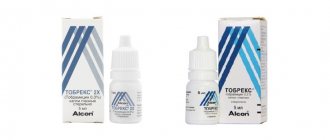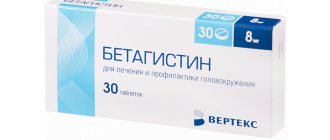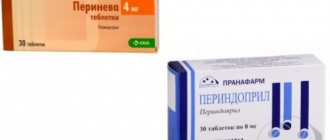Composition and dosage form of the drug
The active compound of the drug is Gabapentin, which acts on specific centers of the brain. Effective for relieving pain and convulsions in epileptic disorders. The medicine is intended for oral administration and is produced in two pharmaceutical forms:
- Gapabentin 300 tablets: containing 300 mg of gabapentin per 1 piece;
- capsules of the same name and dosage.
Among the auxiliary and formative compounds of the drug: starch, talc, magnesium stearin, calcium hydrogen phosphate.
Other pregabalin substitutes
Of these, the following should be noted:
- Pregabalin Richter;
- Pregabalin Canon;
- Algerica.
The first medication is a generic. This is the name for medicines containing the same amount of active substance as the original. The described medicine is more affordable than Lyrica; patients with different levels of financial security can buy it.
And the second medicine is pregabalin-containing. It has the same biochemical properties (digestibility, dosage and side effects). It's also more accessible than Lyrica.
Algerica is produced by a Croatian manufacturer. Its side effects are more pronounced. There is a single dosage (300 mg), it is intended for an intensive course of treatment. Due to the lack of a release form in a lower dose, the risk of drug addiction is increased.
How does Gabapentin work?
An analogue of gamma-aminobutyric acid, Gabapentin, unlike it, does not bind to glutamate, benzodiazepine, or opiate receptors. It acts selectively, directly reducing the activity of the central nervous system centers responsible for the development of seizures during epileptic seizures and other pathological conditions. The drug is not similar to GABA mimetics. In the body, it prevents the penetration of calcium ions through cell membranes, thereby blocking the development of severe pain. At the same time, the drug slows down the death of neurons, preventing further development of the pathological process, and normalizes night sleep.
After administration, the contents of tablets and capsules dissolve under the action of gastric juice and are absorbed into the blood. Food does not affect the rate of absorption of drugs. The effect of the medication develops within 2–3 hours. At the same time, the components of Gabapentin do not bind to blood proteins and practically do not form toxic metabolites. The drug is transformed over 7–8 hours, then gradually eliminated from the body by the kidneys. In case of disturbances in the urinary system, the elimination period can increase to 24 hours. For this reason, adjustments to the treatment regimen may be necessary for people with kidney failure. Residues of the medication do not accumulate inside and are not deposited in tissues.
Non-addictive medications
The free sale of pregabalin and its substitutes in pharmacies is prohibited. But over-the-counter sales are allowed. These include medications, the composition of which is fundamentally different, but the effect is the same.
For fibromyalgia, the following are used as analgesics:
- nimesulide;
- diclofenac;
- ketoprofen.
These pregabalin substitutes inhibit the enzyme cyclooxygenase, which is responsible for the production of prostaglandins, bradykinins and leukotrienes. These are biologically active compounds on which the severity of pain in various pathologies in general and fibromyalgia in particular depends. The described remedies are not ideal - for example, they can cause individual intolerance. But they are valuable because they are not capable of provoking drug addiction.
Popular analogues include gabapentin, finlepsin and carbamazepine. Gabapentin is prescribed for relief of:
- epileptic seizures;
- neuropathic pain;
- postherpetic and alcoholic neuralgia.
Finlepsin and carbamazepine act as agents:
- antiepileptics;
- painkillers;
- normothymic (mood stabilizing);
- antimanic;
- antidiuretic.
Thanks to finlepsin and carbamazepine, the amount of chemicals in the body that lead to excitation and overexcitation of nerve structures is reduced. They do not cause drug addiction, but have other side effects. That is why they should only be prescribed by the attending physician - he knows the physiological characteristics of his patient well.
Anticonvulsant substitutes include Depakine Chrono. It acts like:
- muscle relaxant (relaxes muscles);
- sedative (calming).
Depakine Chrono does not cause mental and physical addiction, like pregabalin - its replacement is justified. It is used in the treatment of epileptic seizures - generalized (the so-called convulsive motor activity that extends to all muscle groups) and partial (those in which there is no impairment of consciousness). It is also effective in treating Lennox-Gastaut syndrome, a severe encephalopathy (brain damage) that first appears in childhood.
For what pathologies is Gapabentin indicated?
The drug is used to eliminate convulsive painful manifestations in the corresponding acute disorders of the central nervous system. Including:
- to reduce focal body convulsions in patients with epilepsy at least 12 years of age: as an independent remedy and in complex treatment of the disease;
- for the treatment of resistant epilepsy that has developed in children over 3 years of age: as an additional medication;
- for severe migraine attacks;
- to relieve pain caused by neuropathic processes: complications of diabetes mellitus, spinal canal stenosis, alcoholic neuralgia and others.
In some cases, Gapabentin is prescribed to menopausal women to reduce painful symptoms of hormonal disorders: headaches, hot flashes, nervous tension. In patients with estrogen intolerance, Gapabentin may be an alternative to replacement therapy.
Comparison of contraindications
Gabapentin and Pregabalin have both similar and different restrictions on use. It is forbidden to drink them if you are hypersensitive or allergic to their components.
Pregabalin is not prescribed in the following cases:
- children under 17 years of age;
- rare pathologies that are inherited;
- pregnancy and lactation period.
Contraindications for Gabapentin include:
- pregnancy and breastfeeding (prescription is possible if the expected result from treatment exceeds the risks for the child);
- for postherpetic neuralgia, age up to 12 years;
- for partial epileptic seizures - up to 3 years.
There have been no adequate and controlled studies on the use of Gabapentin and Pregabalin in children under 18 years of age or in pregnant and lactating women. Therefore, it is recommended to use similar medications for therapy that have proven effectiveness and a minimum of contraindications for these groups of patients.
When comparing the difference between Gabapentin and Pregabalin , it was found that the second is more effective, but has a less wide range of applications. At the same time, Pregabalin has greater toxicity, which causes severe symptoms in case of overdose.
When is Gapabentin contraindicated?
It is necessary to stop using the drug in case of individual hypersensitivity to its components. Other contraindications to the medication:
- acute dysfunction of the pancreas;
- malabsorption syndrome;
- galactose intolerance;
- children's age: under 3 years, for patients with postherpetic neuralgia: under 12 years.
Treatment with the drug is also contraindicated during pregnancy due to the possible harm to the health of the fetus.
Gabapentin or Pregabalin: Differences in Side Effects
Due to the slightly different effects on the body of the main active ingredient of these drugs, their side effects on the body are also very different.
The most common negative consequences of taking Gabapentin include:
- tremor;
- nystagmus;
- peripheral edema;
- ataxia;
- drowsiness;
- fatigue;
- dizziness;
- sometimes erectile dysfunction and loss of libido.
Also, while taking this anticonvulsant drug, dysfunction of almost all body systems is possible.
Pregabalin has much fewer side effects:
- ataxia;
- headache;
- drowsiness;
- dizziness.
Thus, when studying which is more dangerous, Pregabalin or Gabapentin, the comparison showed that the first drug has much fewer negative effects on human health.
Reference! It is important to know that since 2022, Pregabalin has been included in the register of potent drugs and is sold only by prescription.
Side effects of the drug
During treatment with Gapabentin, undesirable reactions from the cardiovascular, nervous, digestive and excretory systems are possible:
- loss of appetite, dry mouth, nausea, impaired intestinal motility;
- dizziness;
- increased drowsiness;
- physical weakness;
- nagging pain in muscles and back;
- depressed mood;
- development of edema;
- surges in blood pressure.
If you have an allergic reaction to the drug, itching, urticaria, inflammation of the oral mucosa, cough, and runny nose are likely to occur. Overdose of the drug increases the risk of acute intoxication. Its signs: confusion of speech and consciousness, impaired coordination of movements, vomiting, acute pancreatitis, tinnitus, decreased vision.
Characteristics of the drug
It is used in the treatment of neurological pathologies such as:
- diabetic neuropathy - damage to peripheral nerves due to diabetes mellitus;
- postherpetic neuropathy is a similar disorder that occurs after suffering from herpes;
- epilepsy - seizures;
- neuropathic pain - those that arise due to overexcitation of nerve cells;
- fibromyalgia - musculoskeletal pain;
- generalized anxiety disorder is a condition characterized by restlessness, worry, and panic.
Addicts use higher doses of this medication to induce a feeling of euphoria. Quite quickly it leads to disorders of various organs. In addition, literally after one or two doses, dependence on pregabalin is formed - replacement with analogues is extremely important because of this.
Of the psycho-emotional disturbances that can be provoked by this drug, the most common are irritability, depression, and hallucinations. The most common neurological disorders are insomnia, headache, dizziness. Typical somatic consequences are disturbances in the functioning of the cardiovascular, respiratory and digestive systems.
How to use Gapabentin: instructions
Tablets and capsules of the drug are swallowed whole with water. The periods of taking medication and food are not related. The daily dosage and treatment regimen depend on the condition of the patients:
- on the first day: from 1 to 3 pills;
- subsequently the dose is gradually increased if necessary;
- maximum dose per day: 3600 mg (12 tablets), divided into equal portions.
If side effects are detected, you should seek additional advice. Abrupt withdrawal of the drug, according to reviews, leads to significant changes in mood, insomnia, and anxiety. During the therapy period, it is necessary to refrain from strenuous work and driving.
The most popular substitute is Lyrica.
This is a medicine whose active ingredient is pregabalin. It has analgesic and anticonvulsant effects. It causes euphoria, which is why it is popular among those who like to “expand consciousness”. The side effects are the same as when taking pregabalin - analogues, as it turns out, are not always a solution to the problem. With uncontrolled use of Lyrica, addiction is formed and disorders occur:
- mental - irritability, depression, panic, aggressiveness;
- neurological - dizziness, drowsiness, nervous exhaustion, convulsions.
The most common somatic disorders are system failures:
- cardiovascular - arrhythmias, signs of heart failure;
- respiratory - increased breathing, cough, nasal congestion;
- digestive - nausea with vomiting, constipation or diarrhea;
- urinary - enuresis (urinary incontinence).
Please note: An addiction to Lyrics develops quickly. When prescribing it, it is necessary to monitor patients who have been identified as drug dependent. They may experience suicidal thoughts, and this is also an indication for medical supervision.
Literature:
- Pharmacology of antiepileptic drugs: a textbook for students in specialty programs “General Medicine”, “Pediatrics”, “Pharmacy” / I. A. Vinogradova, V. D. Yunash, S. V. Goranskaya [etc.]; Ministry of Science and Higher Education of the Russian Federation, Federal State Budgetary Educational Institution of Higher Education Petrozavodsk State University. — Petrozavodsk: PetrSU Publishing House, 2021. — 32 p.
- Kozlovsky, Vladimir Leonidovich. / Brief reference book on psychopharmacology, pharmacotherapy and mental pathology - St. Petersburg: SpetsLit, 2015.
- Neurology: national guide / Avakyan G. N. et al.; Ch. ed.: E.I. Gusev [etc.]; Assoc. honey. Island for Quality, ASMOK, All-Russian Society of Neurologists. - Moscow: GEOTAR-Media, 2009. - 1035 p.







